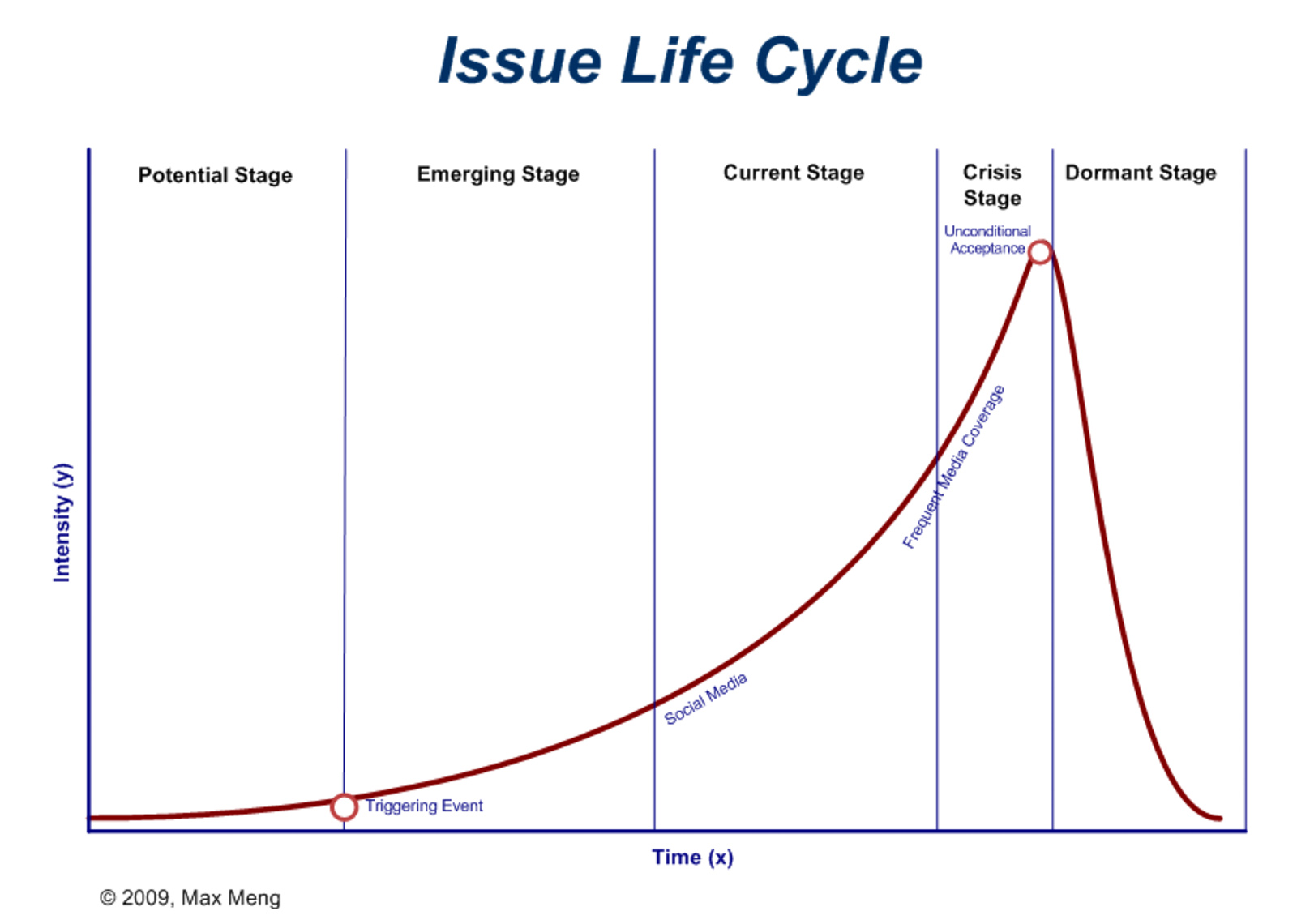Issue Life Cycle clarifies difference between “issues management” and “crisis management”
bySome mistakenly consider issues management as synonymous with crisis management. This oversight is recognized among seasoned practitioners. While it can be argued crisis management, which deals with containment and response, is part of issues management, the later is not crisis driven. Issues management is a planning process used to anticipate emerging issues. It also describes a strategic function, which coordinates an integrated effort to raise the level of the debate through meaningful dialog in hopes of clarifying a position to avoid, if possible, an issue from evolving into a crisis. In fact, the issue life cycle clearly distinguishes the difference between these two concepts.
Referring to the figure (see above) of the issue life cycle, the X-axis represents duration in which an issue evolves. The Y-axis represents the level of intensity. As the intensity of an issue begins to rise, so does the level of pressure upon the organization for acceptance of the issue.
Issues management encompasses the potential, emerging, and current stages of an issue’s evolution before it reaches the crisis stage. At the crisis stage, a different set of skill sets are necessary where an organization may be forced unconditional accept an issue through formally constrains.

Here is a summary of each stage of the issue life cycle:
Stage 1: Potential issue
This stage consists of a defined phenomenon that has the potential to become an issue of concern. A trend can be referred to as a potential issue. Ideas prompting potential organizational change can also be referred to as potential issues. These types of ideas have not yet captured public attention, even though some experts or key stakeholders may be aware of them.
Situation: The situation is a rallying point or “triggering event” at which stakeholders establish a level of credibility among their constituency and solicits the support of other influencers. At this point, the stakeholder experiences a general sense of uneasiness or frustration, recognizing that a problem exists, and begins proposing changes to an organization. The level of intensity is strong enough to propel the issue forward with an informal or formal campaign for change.
Stage 2: Emerging issue
During this stage, an issue’s level of intensity increase gradually. The increase is mainly because of the stakeholders advancing the issue. During this stage, the stakeholders try to legitimize the issue and gain greater support from expanded circle of influencers to strengthen their position and public acceptance for the issue.
During this stage a targeted organization may choose to respond to the issue by raising the level of debate through meaningful dialog sometimes with the stakeholders in hopes of clarifying its position or even modifying its behavior. However, during this stage the urgency of the issue is sometimes unknown because of the difficulty in determining if the issue will remain moderate or increase in intensity, stay confined to a particular group of stakeholders, or become pervasive, supported by many stakeholders.
Media coverage: Frequent media coverage begins before the issue reaches the crisis stage, which represents formal constraints imposed on the organization. It overlaps a portion of the emerging stage and encompasses the current and crisis stages. Before an issue receives regular media coverage, stakeholders persistently seek to attract the media's attention to its cause. Often sporadic coverage of the issue occurs during the emerging stage. Not until this point of evolution of an issue does regular coverage takes place and this media coverage then becomes a critical phase in the advancement of an issue.
Stage 3: Current issue
The issue at this stage has matured, displaying its full potential impact upon the organization. A current issue is generally enduring, becomes quite pervasive, and attained a high level of intensity. At this point the public, key influencers, and others recognize the importance of the issue and place pressure on governmental bodies and agencies to introduce formal constraints to deter or change the behavior of the organization or industry.
Stage 4: Crisis issue
The issue finally reaches a formal institution that has authority to impose formal constraints in an attempt to resolve it. At this stage, the organization's options have decreased; however, it must set a policy in response to the crisis.
Unconditional acceptance: Through formal constraints, the issue is unconditionally imposed upon the organization or industry. Basically, it has no other alternatives but to accept the issue by deterring or changing its behavior.
Stage 5: Dormant issue
When an issue follows the full course of its life, it eventually reaches a high level of intensity to force the organization to accept it unconditionally. The issue at this point becomes a norm within the organization and in society.
In some cases, however, an issue may not reach a level of intensity necessary to impose acceptance by the organization. It might never obtain the support required to force action. On the other hand, some organizations may choose to accept a limited degree of change in their behavior to appease its key influencers, or to avoid it from progressing to the crisis stage imposed upon it through formal constraints. Furthermore, some organizations may choose to try to intervene in the issue's evolution during its early stages to avoid unconditional acceptance.
Ending on a cautionary note, an issue should never be considered settled. The organization may assume it has avoided the issue by stopping its evolution or even mistakenly believe that the issue is "resolved," but the issue is never "solved" once and for all. At some point another stakeholder or group may initiate its rebirth.
Note: This posting refers to the five stages of an issue’s evolution, which I first published in “Early identification aids issues management,” Public Relations Journal, 1992.